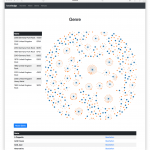TL;DR: Don’t use Open Session in View with a Neo4j-Cluster
If you use Spring Data Neo4j and Neo4j-OGM in your Spring Boot application connectect against a Neo4j cluster (via bolt+routing://, neo4j:// or multiple bolt-uris), configure spring.data.neo4j.open-in-view explicitly to false like this: spring.data.neo4j.open-in-view=false
What is Open Session in View?
Vlad Mihalcea has written extensive amounts about why the Open Session in View Pattern is an Anti pattern these days.
Vlad is well known for his work in JPA and especially hibernate world. What the hell has this to do with Spring Data Neo4j and Neo4j’s Object Graph Mapping (Neo4j-OGM)? It turns out, a lot. We have to bring a couple of things together.
Neo4j routing
This is maybe unexpected, but the first thing we have to understand is Neo4j’s routing mechanism. Neo4j databases are able to run as clusters. The instances of those clusters use the Raft consensus algorithm. Part of that algorithm are leaders, followers and read replicas.
My colleague David allen has a nice post out there on how to query a Neo4j cluster: Querying Neo4j Clusters.
The important stanza for this post is:
The leader is responsible for coordinating the cluster and accepting all writes. Followers help scale the read workload ability of the cluster and provide for high-availability of data. Should one of the cluster machines fail, and you still have a majority, you can still process reads and writes. If your cluster loses the majority it can only serve (stale) reads and has no leader anymore.
Optionally, you can have any number caches in the form of read replicas. They are read-only copies of your database for scaling out read-query load. They are not officially part of the cluster, but rather are “tag along” copies that get replicated transactions from the main cluster.
When you connect to a cluster one of the Neo4j drivers does the job of routing for you everytime you open a connection via the bolt+routing:// respectivly neo4j://. It is said that “the driver is connected to a cluster”. The driver has a routing table, knowing leader, follower and read replicas.
The driver does not parse Cypher on the client side. The only information it has available to pick a host from the routing table is whether you want a read session or a read-write session respectivly transaction. Therefor it is very important to make that choice consciously! Otherwise all request will go to the leader, as that instance will be able to answer all of them.
Neo4j-OGM
Neo4j-OGM is able to support Neo4j cluster and routing via it’s Bolt transport. There are a couple of convience methods on the Neo4j-OGM session that let’s you specify whether it’s a read or a read-write statement you want to run. Neo4j-OGM actually does look into your Cypher and issues a warning if you ask for a read-only transaction but have something like MERGE, CREATE or UPDATE in your Cypher.
So up here it’s all good.
Entering Spring’s @Transactional
Spring’s @Transactional is a great piece of code. It instructs the framework to execute your code in a transactional around aspect: A transaction is opened before your code and closed afterwards, commiting if your code ran without error, rolling back otherwise. A transaction manager takes care that this also works with a explicit TransactionTemplate.
The annotation has an attribute named readOnly. In contrast to a superficial look at it, it doesn’t prevent writes to happen against a database. And how could it? @Transactional is a general purpose mechanism, working with JPA, Neo4j and other databases. It would need mechanisms to find out about your query for all of those. readOnly is merely an indicator to be passed on to the underlying store so that this store configure characteristics as needed. Vlad has written down what it does for Hibernate.
For Neo4j-OGM it just configures the default mode of the Driver’s session: read only or read-write. As we learned above, this is super important to prevent the leader from being hammered by all the queries.
Spring Data Neo4j and Neo4j-OGM supports this in all of the following scenarios, given the following repository and service:
import java.util.Collection; import java.util.Collections; import java.util.List; import org.neo4j.ogm.session.Session; import org.springframework.data.neo4j.annotation.Query; import org.springframework.data.neo4j.repository.Neo4jRepository; import org.springframework.stereotype.Service; import org.springframework.transaction.annotation.Transactional; public interface MovieRepository extends Neo4jRepository<Movie, Long> { @Transactional(readOnly = true) @Query("MATCH (m:Movie) RETURN m.tagline as value") List<SomeResult> findCustomResultWithTxOnRepository(); // Not read only @Query("MATCH (m:Movie) RETURN m.tagline as value") List<SomeResult> findCustomResult(); } @Service public class SomeService { private final MovieRepository movieRepository; private final Session session; public SomeService(MovieRepository movieRepository, Session session) { this.movieRepository = movieRepository; this.session = session; } @Transactional(readOnly = true) public Collection<SomeResult> findCustomResultWithTransactionOnService() { return movieRepository.findCustomResult(); } @Transactional(readOnly = true) public Collection<Movie> findMoviesViaLoadAllOnSession() { return session.loadAll(Movie.class); } @Transactional(readOnly = true) public Collection<Movie>findMoviesViaCustomQueryOnSession() { return (Collection) session.query(Movie.class, "MATCH (m:Movie) RETURN m", Collections.emptyMap()); } } |
All of those understand that none of the queries needs to go to a leader.
Entering OSIV
For Neo4j-OGM, there’s also an OpenSessionInViewInterceptor that get’s configured via Spring Boot by default in a web application. It makes sure there’s an ongoing Neo4j-OGM session along with it’s caches and mapping in place for the whole request.
Why is this bad in a cluster scenario? Because tied to the Neo4j-OGM session there’s the driver session. To allow the user to do anything they want in the request, those sessions need to be read-write sessions. Once marked as read-write, you cannot make turn read only ever again.
That means if you call any of the above scribbeld methods from a REST endpoint, there will already be an ongoing session and the readOnly indicator will be ignored!
So if you connect a Spring Data Neo4j + Neo4j-OGM application against a Neo4j cluster: Go to your Spring Boot configuration (either properties or YAML or Environment) and explicity configure:
spring.data.neo4j.open-in-view=false |
I have raised an issue with the Spring Boot team to discuss changing the default: Open session in view is problematic with Neo4j..






2 comments
Hello, This is a great post. Very helpful.
Can you also please help with another clarification,
For the SPRING’S @TRANSACTIONAL, do we need to configure/enable transaction management or does Neo4jTransactionManager takes care of it by default?
Hi,
thank you very much for your kind feedback.
If you have
org.springframework.boot:spring-boot-starter-data-neo4jon the class path, transaction management will be automatically enabled and you don’t have add an additional annotation or provide aNeo4jTransactioManager/code>-bean.In other words:
@EnableTransactionManagementand the necessary bean is part of the above starter.Post a Comment